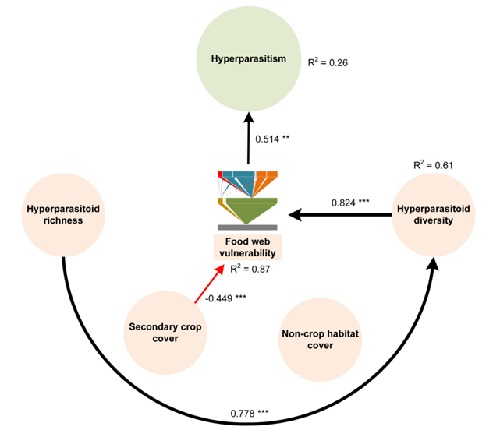Species diversity and food web structure jointly shape natural biological control in agricultural landscapes
Fan Yang, Bing Liu, Yulin Zhu, Kris A. G. Wyckhuys, Wopke van der Werf & Yanhui Lu

生物控害功能与寄生蜂多样性、食物网结构之间的关系 中国农科院植保所供图

重寄生作用与重寄生蜂多样性、食物网结构及景观因子之间的关系 中国农科院植保所供图
8月18日,《通讯生物学》(Communications Biology)在线发表了中国农业科学院植物保护研究所经济作物虫害监测与控制创新团队最新成果。该团队研究发现,农田景观尺度下寄生蜂物种多样性、蚜虫—寄生蜂食物网结构共同调控寄生蜂对棉花蚜虫的生物控制服务功能。
论文通讯作者陆宴辉研究员介绍,寄生蜂是蚜虫类害虫的重要天敌,其控蚜功能常受外部景观格局、内部食物网结构等多方面因素的综合影响。
该项研究历时3年,先后在25个直径3公里的农田景观站点开展试验,基于对每个站点的景观组成、寄生蜂物种多样性、蚜虫-寄生蜂食物网结构、寄生蜂对蚜虫的控制功能进行定量评价和通径分析,发现彼此之间存在着明显的级联效应。
农田景观中高比率的非作物生境显著提升寄生蜂对棉蚜的控制功能,而小宗作物种植比率增加明显降低棉蚜的重寄生率。同时,寄生蜂生物控害功能与蚜虫—寄生蜂食物网结构密切相关,而并非传统认识中寄生蜂物种多样性越高、生物控害作用就越强。
寄生蜂多样性和食物网的普遍性(generality)越高,棉蚜的寄生率反而越低;而次级寄生蜂多样性和食物网易损性(vulnerability)越高,重寄生率也越高。
该研究系统解析了农田景观格局变化及作物种植结构调整对有益天敌发生与控害的影响效应,突出强调了昆虫食物网结构在农业害虫生态调控中的重要功能,为阐明农业害虫地位演替机制、创新棉花蚜虫生态调控策略提供了理论支撑和思路启迪。
中国农业科学院植物保护研究所为论文第一完成单位,博士后杨帆、刘冰及研究生朱玉麟为共同第一作者。该研究得到了国家自然科学基金、国家重点研发计划项目的支持。
来源:中国科学报 李晨
Abstract
Land-use change and agricultural intensification concurrently impact natural enemy (e.g., parasitoid) communities and their associated ecosystem services (ESs), i.e., biological pest control. However, the extent to which (on-farm) parasitoid diversity and food webs mediate landscape-level influences on biological control remains poorly understood. Here, drawing upon a 3-year study of quantitative parasitoid-hyperparasitoid trophic networks from 25 different agro-landscapes, we assess the cascading effects of landscape composition, species diversity and trophic network structure on ecosystem functionality (i.e., parasitism, hyperparasitism). Path analysis further reveals cascaded effects leading to biological control of a resident crop pest, i.e., Aphis gossypii. Functionality is dictated by (hyper)parasitoid diversity, with its effects modulated by food web generality and vulnerability. Non-crop habitat cover directly benefits biological control, whereas secondary crop cover indirectly lowers hyperparasitism. Our work underscores a need to simultaneously account for on-farm biodiversity and trophic interactions when investigating ESs within dynamic agro-landscapes.






 位访客
位访客